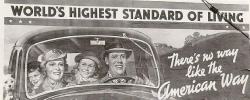The power of images. The power of perspective. It's pretty clear by now that we are going to need a lot more than walls of words, thick reports and endless expert conferences to turn the world toward sustainability. So to help our cause we invite our readers to jump in and  share with us striking their "social space" graphics which illustrate in telling ways the world's streets and all that takes place thereon in many places and in many ways. To get a feel for how this works out using our challenging 990 x 180 pixels format, read on -- or if you are in a hurry click here to go direct to the photo gallery.
share with us striking their "social space" graphics which illustrate in telling ways the world's streets and all that takes place thereon in many places and in many ways. To get a feel for how this works out using our challenging 990 x 180 pixels format, read on -- or if you are in a hurry click here to go direct to the photo gallery. 
Working with a Social Space format
There is more than a bit of the "medium is the message" of Marshall McLuhan in this somewhat unusual elongated rectangular format with, as with poetry, its strict dimension of 990 × 180 pixels. It is, we would say, a basically "social space format". In our mind's eye most of us tend to envisage, to think of many things out there in front of our noses in terms of squares or rectangles, which naturally enough is how most of us end up taking our pictures.
But this elongated frame takes us beyond a single individual subject and the eye travels quite further than usual and in the process brings us to think, yes, of more social spaces. Have a look at some of the following examples and see for yourself if this makes any sense at all.
Portugal's Streets:
Just this morning for instance we had the luck to receive and to be able to share with you the splendid street scene you see above, showing an intersection of bus services right in the middle of the beautiful city of Lisbon. And all this thanks to our colleague Miguel Barroso from Lisbon.
The shot is taken from the city's historic Praça do Comércio (Commerce Square), and just behind those columns you enter into the city's pedestrian network. Makes you want to go to Lisbon, eh?

India's streets:
A few weeks ago, this next great shot was shared with us by Karthik Rao-Cavale, whose fine new blog "India lives in her cities too!" with its sub-title "A closer look at Indian cities, streets and neighbourhoods" at http://vishwakarman.wordpress.com/ -- is a thoughtful source for anyone who shares WOrld Streets interests and concern.
Karthik wrote when he sent it along to us: "I took the photo in 2008 on one of my solitary travels, in the large city of Calcutta. Here's the link to the larger version. http://vishwakarman.files.wordpress.com/2010/07/100_08094.jpg. The background is the famous Howrah Bridge on the river Hooghly."

Homage to a Fallen City:
For this thought-provoking image we sent warm thanks to Beatrice Jarvis, a young British choreographer, photographer and urban researcher. You can visit her website and see her photographs in Urban Re-Passages at : beatricejarvis.wordpress.com/

A striking example from Cambodia
What you see here is a 990 x 180 section of a photograph taken by Jeroen Swolfs (www.jeroenswolfs.nl) who has launched a Dutch project entitled Streets of the world (http://www.streetsoftheworld.nl) in which he is reporting on his world-wide pictorial vagabondage which thus far has had him photographing life on more than forty countries on four continents thus far. We have invited him to share some of his photos with us occasionally and hope you will be seeing him often on World Streets.

A Paris homage:
Here to close out this introduction is an example of using our strange format as a frame for a part of an image and, we would say, to some good effect. The orignal graphic appeared in a story from the New York Times to what our earnest editor contributed: "Watery future for the City of Light". It looked like this:
 Well, very nice indeed but we could not use it as our feature graphic for the story and the week, so we needed to find what would work out with our demanding format, to which challenge we came up with this.
Well, very nice indeed but we could not use it as our feature graphic for the story and the week, so we needed to find what would work out with our demanding format, to which challenge we came up with this.

You may like it or not, but there is no denying that this is a social format. And that is exactly what we are looking for.
Now it's your turn:
And if you have striking social space candidates for this unusual slot -- 990 × 180 pixels -- let us hear from you. We believe in getting all the media behind these important social and environmental goals. (Please be sure to let us know the where and when of the image, along with the source so that we can correctly credit it.)
Thanks for sharing, and again click here for the latest collection of social space photos from World Streets.
Eric Britton, Editor. Skype: newmobility. Tel. +336 5088 0787
--> Read on:



















